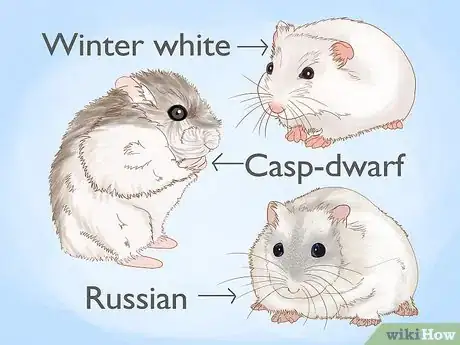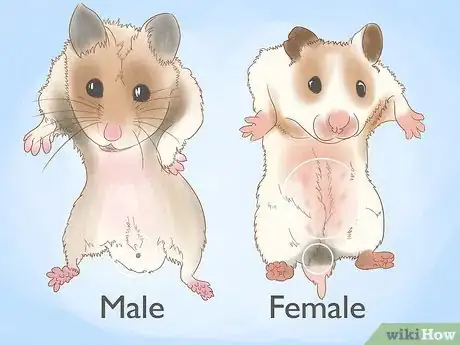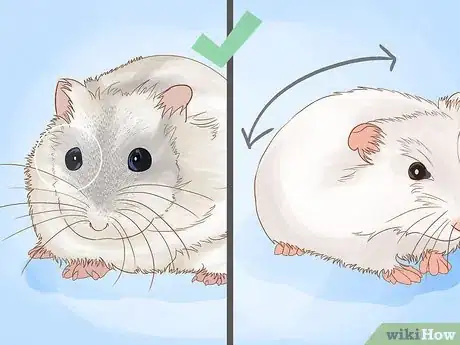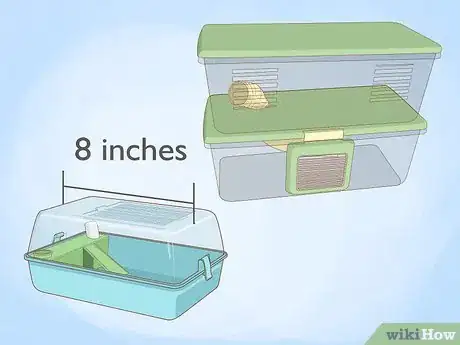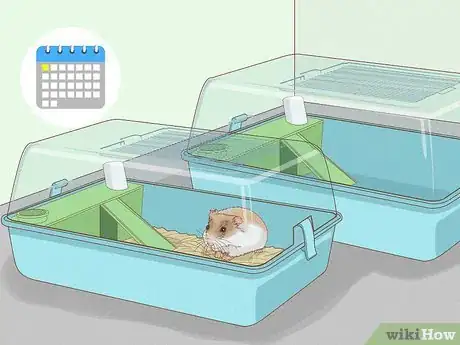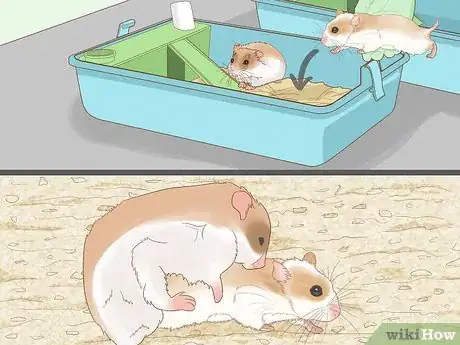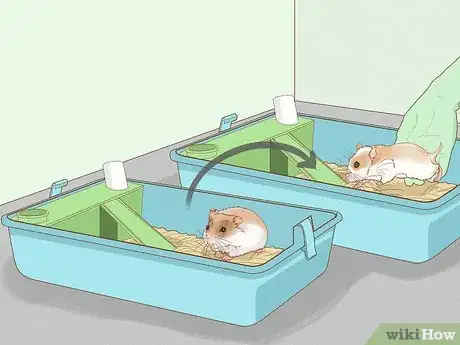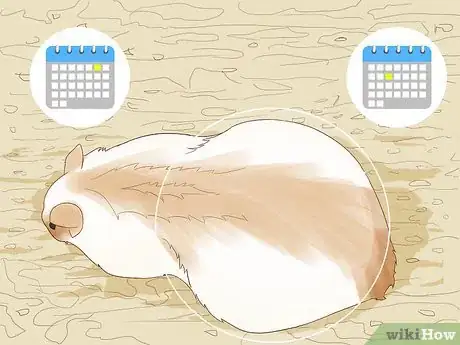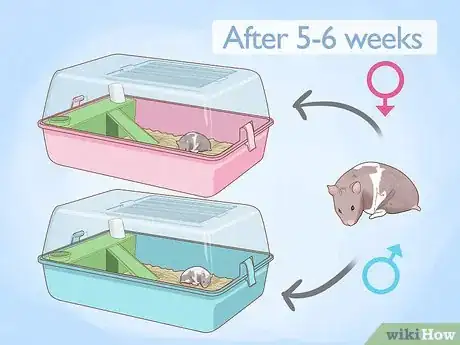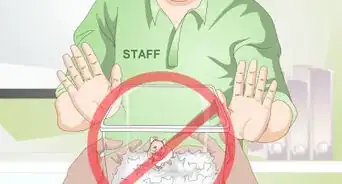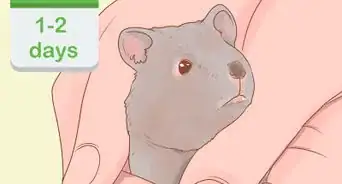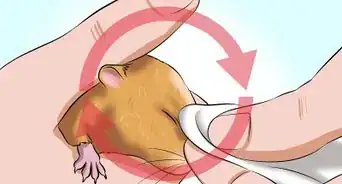wikiHow is a “wiki,” similar to Wikipedia, which means that many of our articles are co-written by multiple authors. To create this article, 141 people, some anonymous, worked to edit and improve it over time.
This article has been viewed 659,496 times.
Learn more...
Cute and cuddly, hamsters make wonderful pets. Breeding them isn't always a simple task; buying two random hamsters and breeding them can be dangerous for both the mother and her pups. Although difficult, breeding hamsters is a fun and rewarding way to provide pets to friends and family. Once you have homes lined out for the hamsters-to-be, here's what to do.
Steps
Buying Hamsters for Breeding
-
1Decide what type of hamsters you want. Syrian hamsters are good pets, partially because they are solitary animals, but they can be quite hard to breed. If the male and female are introduced at the wrong time, they may fight. Dwarf hamsters are thought to be nippy with humans, but are more social with each other, and can actually be easier to breed.
- There are also Russian hamsters, winter white hamsters, and other varieties. If you're buying from a breeder, talk about the different varieties and discover whether they are social or not, to have some sense of the breeding process.
-
2Get a male and female. It's best to get your breeding hamsters from a breeder, so you have a wide selection of colours and types. It's also good to know the breeding history of the hamsters.[1]
- At a pet shop, you will often find siblings or hybrid breed hamsters that are less desirable for breeding. Also, pet store workers often have a difficult time telling the difference between males and females.
Advertisement -
3Look for hamsters that are in good health. Make sure that their eyes are clear and bright, their fur is smooth and glossy, and that they look active and interested in their surroundings.
-
4Buy two large cages for your hamsters. Plastic bin cages or aquariums are a massive advantage in breeding. Put one hamster in each cage and fill the bottom with wood shavings, megazorb, or carefresh. Try to avoid sawdust, as this gets into hamsters' eyes and can affect their breathing.
- Avoid wire cages. Hamsters, especially newborn ones, can squeeze out through them.
- Get a small plastic or preferably wood "hamster home" for your hamster to huddle in. Fill it with some of the same shavings as in the cage.
- A hamster wheel is also a must for the habitat. For dwarf hamsters the size can be almost any size, as long as they are able to use it, but for Syrians it must be more than 8 inches (20.3 cm), and it should be plastic, not wire, as holes in these wheels are very likely to harm your hamster. Also, never give your hamster a wheel where it's running with an arched back, even just a little, as that can cause serious health problems.
- You'll also need a water bottle, food bowl, hamster food, treats, and anything else that you can think off.
-
5When you bring each of your hamsters home, allow it at least a day alone. Don't handle them or take them out of their cages, but make sure the habitat is well stocked to help your hamsters get used to their new environment without disruption. It is best to start handling them the day after you bring them home. If your new hamster hasn't been handled a lot then be prepared to tame them.
Breeding Your Hamsters
-
1Wait until the female is in heat. When hamsters are 28 days old, they will reach their sexual maturity. The female enters heat roughly every 4 days. When the female is in heat, it will behave much like a cat in heat, crouching low to the ground and raising its tail. You may also notice that the hamster is smellier than usual because it is giving off pheromones.[2]
- If the female is not in heat, trying to breed them can be very dangerous and counterproductive. The female will often fight and kill the male.
- When you're planning on breeding them, place the two cages side by side for a few days, so they can see and get used to each other, and so the pheromones can do their work.
-
2Put the female into the male's cage. Hamsters are nocturnal animals, so it's best to start in the early evening. Put them into the neutral territory or the male's cage. A spare cage is a good option, as she is more likely to attack the male if he is put in her cage. If they start fighting, remove one hamster from the cage, and try again another day.[3]
- Keep following these steps until they mate. If you miss the "heat" window, wait for a few days until it comes back around.
-
3Isolate your female hamster once the mating is over. While some male hamsters will care for the babies, some others will attack and eat them. It's best to be on the safe side, even if you have a kind and loving male hamster, to separate him for the duration of the gestation and birth, which should only be about two weeks.
- If you're breeding dwarf hamsters, the time to reach sexual maturity and the gestation period are slightly longer. It takes one month to 5 weeks for a dwarf hamster to reach sexual maturity, and the gestation period is about three weeks. However, no hamsters under 5(for males)/6(for females) months should be bred as this increases the risk of something going wrong.
Birthing the Hamsters
-
1Wait. At this stage, you need to be patient and watch the progress. If your female is pregnant, she should start "showing" within a few days, and by the time she's ready to give birth will have very prominent "saddlebags" on each side. You don't need to do anything special, just avoid holding the hamster roughly and leave the hamster alone.
- You will know the babies will be born soon when the female becomes particularly restless. She wanders around her cage, gathering food and nesting material for her nest. Then labor begins: you see her sides starting to heave and tiny pink bodies begin to emerge. One by one, they are born while she is on the move in her cage, and one by one, she carefully picks them up in her mouth and brings them back to the nest.
- When the hamster gives birth, do not attempt to interfere or help in any way. Birth, especially the first birth, is often difficult on the hamster, but there's nothing you can do to help at this point. Just avoid interference and let nature take its course.
-
2Look for the babies. It is during this time and the days that follow that you must take extra care not to disturb her. If she leaves any pups lying around the cage, you must not touch them. If for some reason you must, rub a spoon well into the substrate, then scoop them up in it and return them to the nest.
-
3Allow the mother to nurse for three weeks without any disturbance, not even cleaning the cage. Leave her, the cage, and especially her babies alone, except for discreetly topping up her food and water. This is particularly important for the first time mother, who under stress, has been known to kill and even eat her babies.
- Don't assume the mother is eating the babies if she puts them in her mouth. This happens if she is startled and thinks they are in danger.
-
4Wait three and a half weeks. At this point, it's safe to separate the new hamsters and determine their genders. They become sexually mature at 5-6 weeks, and you do not want sibling breeding, that will cause genetic disorders. Keep females in one cage, males in another for another two to three weeks until they go to their new homes.[4]
Community Q&A
-
QuestionHow old do the hamsters have to be when you sell them ?
 Community AnswerOnce you can determine their gender (3 or 4 weeks), it's time to think about selling them. However, you should find homes beforehand, just so that you are prepared.
Community AnswerOnce you can determine their gender (3 or 4 weeks), it's time to think about selling them. However, you should find homes beforehand, just so that you are prepared. -
QuestionIs there a specific time of year good for breeding?
 Community AnswerUsually, hamsters are in mating season all year round Avoid breeding them during winter, however, as the female will feel that it is too cold for her pups to thrive.
Community AnswerUsually, hamsters are in mating season all year round Avoid breeding them during winter, however, as the female will feel that it is too cold for her pups to thrive. -
QuestionHow many babies do hamsters have?
 Hamster_PawsCommunity AnswerThe average is 4-5, although they can have as few as 2 or as many as 12.
Hamster_PawsCommunity AnswerThe average is 4-5, although they can have as few as 2 or as many as 12.
Warnings
- Make sure that you can afford to look after up to 20 or more hamsters in case you can't find homes.⧼thumbs_response⧽
- Do not attempt to breed a female hamster that is not in heat.⧼thumbs_response⧽
- Get advice and guidance from a well-respected breeder. One wrong move and you might be responsible for the death of a litter of hamsters.⧼thumbs_response⧽
- Keep in mind that some information on the internet is false. Ask a well-respected breeder to confirm anything you read.⧼thumbs_response⧽
- Do not stress the mother out; this increases the chance that she will kill some of the offspring.⧼thumbs_response⧽
- Do not sell or give hamsters to pet stores. Chances are they'll spend the rest of their life in a cage.⧼thumbs_response⧽
- Do not breed winter whites with Campbell's dwarf hamsters. This will create hybrids, which are the "Russian hamsters" you see in pet shops. It can result in the mother dying in pain due to the different sizes of the babies and health problems for the offspring.⧼thumbs_response⧽
References
About This Article
To breed your hamsters, start by housing the male and female hamster in separate cages to keep them from fighting. Once the female exhibits signs of being in heat, like crouching low and raising her tail, place her in the male’s cage since she’s likely to attack the male if he’s put into her cage. Additionally, put her into the cage in the evening, as hamsters are nocturnal animals. If the hamsters start fighting, remove the female immediately and try again the next day. After mating, keep the female in her own cage to prevent the male from attacking the babies. To learn more, like how to take care of the hamster babies once they’re born, keep reading!
